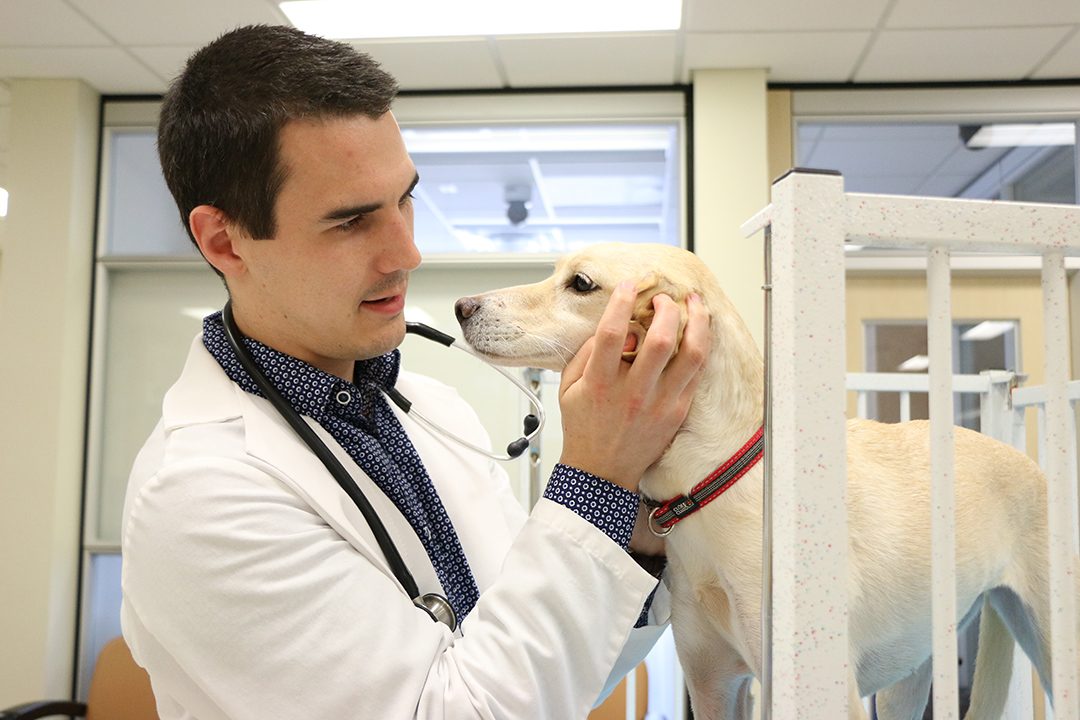
Study’s insights may help expedite Addison’s disease diagnosis
Researchers at the University of Saskatchewan (USask) have identified some unique characteristics that most dogs show when they’re critically ill due to Addison’s disease — insights that may help veterinarians identify severe cases more quickly.
By Cat ZensAddison’s disease (canine hypoadrenocorticism) is caused by a lack of cortisol and aldosterone, two essential hormones made by the adrenal glands. While the disease is manageable in dogs, it can be fatal in severe cases or if it’s left untreated. Affected dogs require lifelong steroid therapy to supplement their hormone levels and manage the disease.
The research study’s findings, which were published in the Canadian Veterinary Journal in July 2023, are based on a review of 84 cases involving dogs that were diagnosed and treated for Addison’s disease between 1998 and 2018 at the Western College of Veterinary Medicine’s (WCVM) Veterinary Medical Centre in Saskatoon, Sask.
In non-critical cases of Addison’s disease, dogs may have less severe signs such as mild diarrhea or softer stools. But critically ill animals can have a hypoglycemic crisis that causes low blood sugar and potential seizures. Severely ill dogs can also show signs such as vomiting, diarrhea, very low blood pressure and electrolyte changes — potentially leading to cardiac arrhythmias or other severe heart issues.
After reviewing the WCVM patients’ medical records, WCVM scientists found that collapse and depression were more commonly reported in critically ill dogs along with vomiting, diarrhea and shock. Researchers noted that many of these dogs in shock had normal lactate levels, despite a high lactate being traditionally associated with shock.
“If you’re healthy and doing well, your lactate would be low … if you’re in shock and you’re really dehydrated, your lactate increases,” says Dr. Nolan Chalifoux, the study’s lead author. “But [in this study], the dogs’ lactate rates were still normal, and the majority of them didn’t have this [lactate] increase.”
Stress hormones — including cortisol — may play a role in blood lactate formation. Chalifoux suggests that many dogs with Addison’s disease may not have high lactate rates because they don’t get enough cortisol, which may prevent lactate rates from rising.
“I think the main takeaway for someone who is working in an emergency clinic or an ICU is that these dogs might not be acting the way a normal dog acts if they’re in shock — they might not have that high heart rate or that high lactate level,” says Chalifoux.
The WCVM research team found that Addisonian dogs in critical condition were more prone to a history of collapsing at home or having generalized depression. They also discovered that some sort of separation — such as owners going away on vacation — was one of the most common precipitating stressors in dogs with Addison’s disease.
“A lot of people who have dogs with Addison’s disease are told that if there is a potential stressful situation happening, they should increase the dose of steroids that these dogs are on to help control their disease,” says Chalifoux, a 2019 graduate of the WCVM’s Doctor of Veterinary Medicine (DVM) program.
He’s now a board-certified critical care specialist at a specialty and emergency pet hospital in Philadelphia, Penn., after completing an emergency and critical care residency program at the University of Pennsylvania in 2023.
Chalifoux conducted the retrospective study in 2018 when he was a WCVM summer research student with Dr. Elisabeth (Liz) Snead, a small animal internal medicine specialist in the college’s Department of Small Animal Clinical Sciences. The study’s other co-authors include Dr. Lyndsay Kong, a 2014 WCVM graduate, WCVM veterinary pathologist Dr. Hilary Burgess, and Dr. Cindy Feng, an adjunct faculty member at USask School of Public Health.
Chalifoux was inspired to look deeper into Addison’s disease because of his interest in critical care medicine. He particularly wanted to examine the differences between critical and non-critical cases of Addison’s disease. Chalifoux and his colleagues went through medical records of the study’s cases, comparing blood test results, physical exams, owners’ descriptions of clinical signs, and other data.
“The thought and idea came from having some of this data pulled to go through and look to see what differences we could find between dogs … that are stable and seeing an internal medicine specialist as opposed to the dogs that are really, really sick and coming in through the emergency service because they are having a crisis,” he says.
The researchers also wanted to analyze the shock index of the dogs, which looks at how shock reactions occur based on a dog’s heart rate and blood pressure.
“With Addison’s disease, when dogs don’t have enough circulating cortisol and stress hormones, we know that a lot of the time they don’t get that really high heart rate that we would expect when they’re in shock,” says Chalifoux.
“Our objective was to look at this general shock index that’s used in dogs of all sorts and see if it could be applied to this specific patient population.”
Chalifoux hopes the study’s findings help veterinarians understand that dogs with Addison’s disease may not present their clinical signs in the expected way.
“I hope that people will better recognize these dogs have an ambiguous disease process, and hopefully, we’ll be able to save more dogs by recognizing [the disease] earlier.”
Cat Zens of North Battleford, Sask., is a fourth-year student in the University of Regina’s School of Journalism. She worked as a WCVM research communications intern in 2023.
